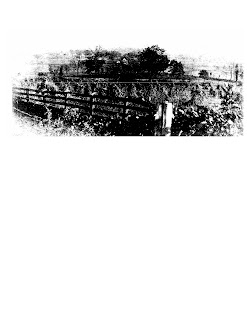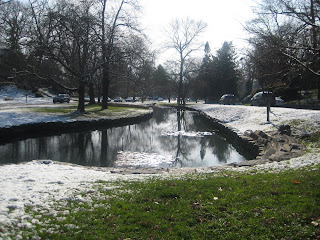 The can be seen when entering Homeland. (Taken by myself)
The can be seen when entering Homeland. (Taken by myself)Homeland, Maryland is a small residential area in Baltimore. This neighborhood might be one many people from Baltimore are not as familiar with, especially considering that Homeland was not even part of the city till 1918 when the city line moved (Stevens, 7). Even though that might be the case, Homeland’s development and community have exhibited what suburbanization was like in many American cities.
Homeland was originally an estate owned by David Perine. The Perine family helped with expanding and establishing their estate before they sold it. The Perine family helped start up the Church of the Redeemer, the first and most prominent church, in 1855 (Leward, 18). In 1872, David Perine sold land to the School of the Sisters of Notre Dame, which is now the College of Notre Dame (Stevens, 9). David Perine’s son, Elias Glen, donated the No. 22 branch of the Enoch Pratt Library in 1919 (Leward, 18).
The Roland Park Company bought Homeland in 1924. The company had already developed the surrounding communities of Roland Park and Guilford making Homeland the company’s third development (Leward, 19). The timing of Homeland’s development was critical to it being another success for the Roland Park Company. The Roland Park Company understood that there was a growing market for housing after World War One and intended on supplying Baltimore with the suburban housing they wanted (Leward, 21).
The Roland Park Company made many efforts in order to apply to the people who wanted to move to the new glamorous suburbs. The Roland Park Company kept the name of “Homeland” because of it being fitting for a residential area (Stevens, 19). The people wanted to move to the suburbs for being around nature and have privacy (Waesche, 61). This was achievable considering that Homeland was known for its produce made on the local farms (Stevens, 8). Citizens just knowing that Homeland was a development of the Roland Park Company would associate them with high class because of them opening the first country club in Baltimore attracting the “right people” (Waesche, 65).
This is an advertisment for row homes trying to compete with the new housing developments by trying to draw people in with "Pure Air and Beautiful Scenery" (North Baltimore:from estate to development. Page 30).

This is a picture of meadows in Homeland, which drew residents in. (North Baltimore: from estate to development. Page18).

 This a picture of a fox that a resident saw in their back yard. http://www.homelandassociation.org/Fox%20Dec%202005.JPG
This a picture of a fox that a resident saw in their back yard. http://www.homelandassociation.org/Fox%20Dec%202005.JPG


